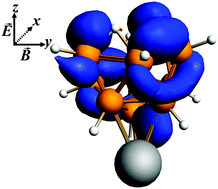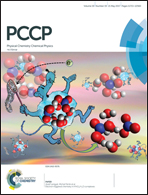The behavior of a paramagnetic system in electric and magnetic fields as exemplified by revisiting Li@B10H14†‡
Abstract
The electric and magnetic properties of the Li@B10H14 complex, considered as a novel inorganic electride-type system with potential for second-order non-linear optical (NLO) applications, have already been studied. However, the reported C2v structure is not the global energy minimum and therefore its electronic and magnetic properties need to be revisited. Moreover, by applying more accurate computational protocols (ROHF-CCSD/CCSD(T) and larger basis sets) we show that the model chemistry used earlier (UMP2/6-31+G(d)) is not sufficient for reliable description of the NLO responses of this open-shell doublet complex. The global minimum based on the Cs symmetry is significantly (by ca. 25 kcal mol−1) more stable than the C2v structure and it should be viewed as a system with moderate NLO responses. An excess of unpaired electron density is also responsible for the contact and pseudo-contact contributions to the magnetic properties, which was not considered in the earlier work.



 Please wait while we load your content...
Please wait while we load your content...